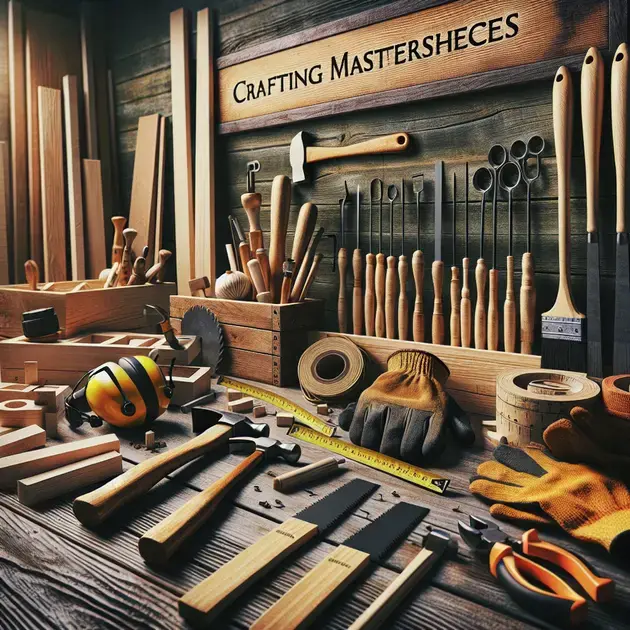Woodworking has been a timeless craft that allows individuals to unleash their creativity and craftsmanship. Whether you are looking to build a simple shelf or a more intricate piece of furniture, mastering the art of woodworking can be a fulfilling and rewarding journey.
With the right tips and techniques, beginners can dive into the world of woodworking with confidence. From selecting the right wood for your projects to understanding essential tools and safety measures, this guide will provide valuable insights to help you kickstart your woodworking skills.

Tips for choosing the right wood for your woodworking projects
When it comes to woodworking projects, selecting the right type of wood is crucial for the success of your endeavors. Here are some tips to help you choose the most suitable wood for your projects:
1. Understand the different types of wood:
Before starting your project, it’s important to familiarize yourself with the various types of wood available. Hardwoods like oak, maple, and cherry are known for their durability, while softwoods like pine and cedar are easier to work with.
2. Consider the project requirements:
Each woodworking project has specific requirements in terms of strength, appearance, and workability. For furniture that needs to bear weight, hardwoods are a better choice, while softwoods are ideal for decorative pieces.
3. Check the wood’s moisture content:
Moisture content is a critical factor in choosing wood for your projects. Wood with high moisture content can warp or shrink once it’s used, so opt for wood that has been properly dried and seasoned.
4. Examine the wood for defects:
Inspect the wood for any defects like knots, cracks, or splits that could affect the quality of your finished piece. Choosing wood without defects will ensure a smoother and more professional outcome.
5. Choose sustainably sourced wood:
For environmentally conscious woodworking, opt for wood that is sustainably sourced and certified by organizations like the Forest Stewardship Council (FSC). This ensures that your woodworking projects are not contributing to deforestation.
Essential tools every beginner woodworker should have
As a beginner woodworker, having the right tools is essential for mastering the craft and creating quality projects. Here are some essential tools that every beginner should have in their woodworking toolkit:
1. Measuring tools:
Accurate measurements are key to successful woodworking projects. Invest in a tape measure, combination square, and a marking gauge to ensure precise cuts and fits.
2. Cutting tools:
Basic cutting tools like a saw (circular saw or handsaw), jigsaw, and miter saw are essential for cutting wood to size and creating joints. Choose high-quality blades for clean and accurate cuts.
3. Sanding tools:
Sanding is a crucial step in woodworking to achieve smooth and polished surfaces. A random orbit sander, sandpaper in various grits, and sanding blocks are must-have tools for finishing your projects.
4. Clamps:
Clamps are indispensable for holding pieces of wood together during glue-ups or when creating joints. Having a variety of clamps like bar clamps, pipe clamps, and spring clamps will assist in securing your workpieces effectively.
5. Safety gear:
Prioritizing safety in woodworking is essential. Invest in safety gear like goggles, ear protection, and a dust mask to protect yourself from potential hazards while working with wood.
Safety first: important measures to ensure a secure woodworking environment
Woodworking can be a rewarding but potentially hazardous activity if proper safety measures are not followed. Here are some important steps to ensure a secure woodworking environment:
1. Wear appropriate safety gear:
Always wear safety gear like goggles, ear protection, and a dust mask to protect yourself from sawdust, flying debris, and loud noises while woodworking. Investing in quality safety gear is a must for every woodworker.
2. Maintain a clutter-free workspace:
Keep your woodworking area clean and organized to prevent tripping hazards and accidents. Clear away sawdust, scraps, and clutter regularly to maintain a safe working environment.
3. Follow proper tool usage guidelines:
Before using any woodworking tool, read the manufacturer’s instructions carefully and follow proper usage guidelines. Improper tool handling can lead to accidents and injuries, so always use tools as intended.
4. Secure workpieces during cutting:
When cutting wood, ensure that workpieces are securely clamped or held in place to prevent unexpected movement. This will reduce the risk of kickbacks and injuries while operating cutting tools.
5. Educate yourself on woodworking safety:
Stay informed about woodworking safety practices by taking courses, reading books, or watching online tutorials. Understanding potential hazards and how to mitigate risks will help you create a safe woodworking environment for yourself and others.

Choosing the best wood finishes for your woodworking projects
When it comes to completing your woodworking projects, choosing the right wood finish is essential for not only enhancing the beauty of the wood but also protecting it from wear and tear over time. With so many options available in the market, it can be overwhelming to decide which finish is best suited for your specific project. Here are some key factors to consider when choosing the best wood finishes:
1. Consider the type of wood:
The type of wood you are working with will play a significant role in determining the best finish. Different woods absorb finishes differently, so it’s important to select a finish that complements the natural characteristics of the wood. For example, while a glossy finish may enhance the richness of darker woods like mahogany, it may not work as well on lighter woods such as pine.
2. Determine the level of protection needed:
Depending on the intended use of the woodworking project, you may need a finish that provides a higher level of protection. For high-traffic pieces like tabletops or outdoor furniture, a durable finish like polyurethane may be the best choice. On the other hand, for decorative pieces that won’t be heavily used, a simpler finish like shellac or wax may suffice.
3. Consider the desired aesthetic:
Wood finishes come in a variety of sheens, from matte to high gloss. The sheen level can significantly impact the overall look of the piece, so it’s essential to consider the desired aesthetic before choosing a finish. For a more natural look, a matte or satin finish may be preferable, while a high gloss finish can add a modern touch to the woodworking project.
4. Test the finish:
Before applying the chosen finish to the entire project, it’s recommended to test it on a small, inconspicuous area of the wood to ensure it delivers the desired results. This step will help you determine how the finish interacts with the wood and whether any adjustments need to be made before proceeding with the full application.
5. Follow the application instructions:
Each wood finish comes with specific application instructions, including the recommended number of coats, drying times, and sanding between coats. It’s crucial to follow these instructions carefully to achieve the best results and ensure the longevity of the finish on your woodworking project.
Mastering the basics: essential woodworking techniques for beginners
For beginners embarking on their woodworking journey, mastering essential techniques is key to achieving successful and satisfying projects. While woodworking can seem intimidating at first, learning the fundamental skills will set a solid foundation for future woodworking endeavors. Here are some essential woodworking techniques for beginners:
1. Safety first:
Prioritize safety by wearing appropriate protective gear such as goggles, ear protection, and gloves. Familiarize yourself with the proper way to handle tools and machinery to prevent accidents and injuries. Always follow safety guidelines and instructions provided with each tool.
2. Learn how to measure and cut accurately:
Precision is crucial in woodworking, so mastering the art of measuring and cutting accurately is essential. Invest in a quality tape measure, square, and saw to ensure your cuts are precise and your projects fit together seamlessly.
3. Practice proper sanding techniques:
Sanding is an essential step in woodworking to achieve smooth and professional-looking finishes. Start with a coarse grit sandpaper to remove imperfections and gradually progress to finer grits for a polished result. Remember to sand in the direction of the wood grain for best results.
4. Understand wood joinery:
Wood joinery techniques such as butt joints, dado joints, and mortise and tenon joints are fundamental to creating strong and durable woodworking projects. Take the time to learn and practice different joinery methods to expand your woodworking skills and capabilities.
5. Experiment and practice:
Woodworking is a skill that improves with practice, so don’t be afraid to experiment with different techniques and projects. Start with simple projects and gradually challenge yourself with more complex designs as your skills develop. Remember that mistakes are part of the learning process, so embrace them as opportunities to grow as a woodworker.
**
Conclusion
**
Choosing the best wood finishes for your woodworking projects is a crucial step in enhancing the beauty and longevity of your creations. Considering factors such as the type of wood, level of protection needed, desired aesthetic, testing the finish, and following application instructions are essential for a successful outcome. By understanding how different finishes interact with various wood types and their specific requirements, you can ensure that your project not only looks stunning but also remains durable over time.
Mastering woodworking techniques is fundamental for beginners to embark on a fulfilling woodworking journey. Prioritizing safety, mastering accurate measurements and cuts, practicing proper sanding techniques, understanding wood joinery, and embracing experimentation are key elements in honing your woodworking skills. Safety should always be a top priority, followed by precision in measurements and cuts to achieve seamless projects. Sanding techniques play a crucial role in achieving a professional finish, while knowledge of wood joinery ensures the strength and durability of your creations.
Remember, woodworking is a skill that thrives on practice and experimentation. Starting with simple projects and gradually progressing to more complex designs allows you to grow and improve your abilities. Embrace mistakes as learning opportunities, and continue to challenge yourself to expand your skill set. By mastering essential woodworking techniques and selecting the right wood finishes, you can create beautiful and long-lasting woodworking projects that showcase your craftsmanship and creativity.